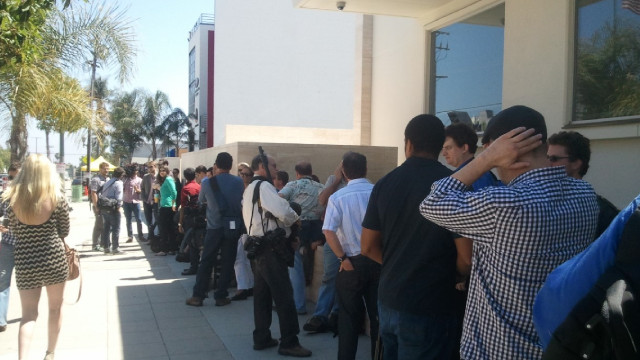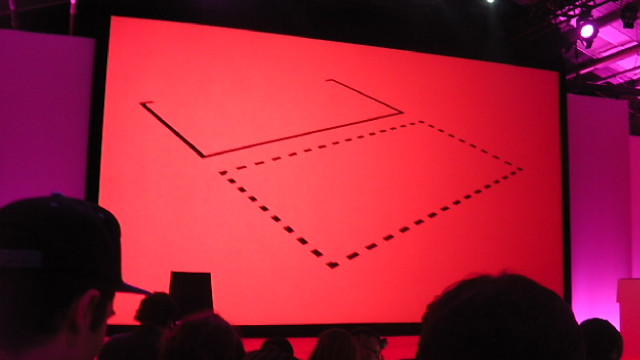June 18, 2012 got off to a very odd start for me. I woke up bright and early in San Francisco – where, two days later, I would be covering the Windows Phone 8 announcement – and zoomed off to the airport, still half-asleep, to catch a flight for the short hop down to Los Angeles.
As I loaded up on coffee at the airport, my phone was starting to heat up from the number of calls, text messages and emails going back and forth between me and my colleagues at Neowin. All of these communiqués were more or less identical; I would be frantically asking “Where the hell am I going?!” and the replies would come back: “We don’t know! We’re trying to find out!”
On the TVs in the airport terminal, all the morning news shows seemed to be talking about the same thing, reporting what I already knew: Microsoft had invited the world’s media to LA for a major new product launch, but no-one knew what it was launching, and no-one had any idea of exactly where the event was being held.

I landed at LAX around half past 9. The coffee was kicking in and I was ready for action, but to my frustration, my inbox was still devoid of details about where I was supposed to be going. Defeated, I went to find more coffee, and slumped on to a bench outside the terminal, hoping that news would arrive before I got arrested by airport police for loitering.
I contemplated the significance of what Microsoft had achieved here. Without revealing a single detail about its new product, the company had managed to generate a huge storm of publicity around it. People were actually excited about what Microsoft might announce; they were talking about Microsoft with genuine anticipation and a curious sense of wonder. It was like the build-up to an Apple launch but somehow, Microsoft had made itself the object of people’s interest and excitement.
It was over an hour before I finally got word of where to go. I flagged down a cab and told the driver to get me to Milk Studios in Hollywood. The excitement must have been getting to my head, because I added “…and step on it!” to the driver; to my disappointment, he did not.

It was probably for the best, since the event wasn’t due to begin until 3:30pm. I got to the venue, and expertly reconnoitred the area, looking for banners, signs, some hint of what was to come. There was nothing so, again defeated, I found a Subway at which to recharge my batteries – and those of my devices – and waited.

When I returned to the venue, the media had descended en masse. Local news vans were parked around the block, and tech media from around the world were queuing to enter the building. I chatted with various journalists and bloggers, most of whom seemed genuinely impressed by what Microsoft had managed to pull off, without the leaks that frequently ruin the surprise before many major product launches - although that's perhaps not entirely surprising, given that it was partly developed by a team working in "an underground bunker with no windows".

We were soon allowed to enter and take our seats, in a presentation space decorated with branding that would soon become familiar as Microsoft’s marketing machine took to the streets – literally – to promote its new product in the weeks that followed.
Steve Ballmer took to the stage to welcome us to the event, before Steven Sinofsky, Panos Panay and Mike Angiulo introduced an exciting new chapter in Microsoft’s history, as the company announced its first PC hardware in the form of Surface.

There was plenty to like. The design of the tablets was fresh and exciting; the ‘click-in’ keyboard covers offered more than just screen protection, and the kickstand was a thoughtful addition that hinted at Microsoft’s attention to detail in creating the devices. There was some disappointment when we were told that the Surface Pro would launch a full three months after the Windows RT model, but there was enough to be excited about for that not to seem like too much of a disaster.

The tablets themselves impressed with what little we were allowed to experience of them. Microsoft only had the Surface RT on show and didn’t allow much interaction; we were allowed to pick the tablet up, photograph it, play with the Live Tiles on the Start screen a bit, but no more. Even so, it made a positive first impression with its sturdy construction, VaporMg body, robust kickstand and vibrant screen.
The future seemed bright for Surface.
It hasn’t exactly been a runaway success story since then. Surface RT launched in the US alongside Windows 8 in October, followed by Surface Pro in February, but the company has been slow to launch the devices elsewhere. Surface Pro only made it to some other major markets last month, almost a year after announcement, and many countries are still waiting.

Mistakes have been made too. For example, Microsoft extensively promoted its pop-up 'Surface Experience Centres' in the UK press, but when we visited one of the advertised locations, staff there had no idea what we were talking about, with managers saying they hadn't even had any contact from Microsoft.
The company has been notably silent when it comes to discussing sales of the devices; one can only speculate that, if its sales figures were worth celebrating, Microsoft would have shared something about them by now.
A major issue appears to be pricing. For a nascent platform with an immature app ecosystem, Microsoft’s pricing of the Surface RT (from $499) and Surface Pro ($899 and up) certainly raised some eyebrows, particularly when the keyboard covers that were the primary focus of the marketing campaigns ended up being costly extras at $99 for the Touch Cover and $119 for the Type Cover.
It’s perhaps telling that Microsoft is currently giving away these covers free with the tablets, albeit in a limited-time offer. Comparisons have also been made recently with ‘fire sales’ of BlackBerry and HP tablets, as Microsoft sells Surfaces at enormous discounts, to developers and those in education.

But while Surface has had a rocky start, that’s perhaps understandable, given that Microsoft is still finding its feet as it redefines itself as a “devices and services company”. There appears to be much to look forward to as well; rumours persist of an ‘Xbox Surface’, with a focus on gaming and media, while an 8-inch ‘Surface Mini’ is also expected to launch alongside Windows 8.1 later this year.

Next week, just over one year on, I’ll have come full-circle when I return to San Francisco to report from Microsoft’s BUILD conference, and I’ll certainly be hoping that we hear more about the company’s plans for Surface. It’s been an unsteady beginning, but Microsoft has laid some strong foundations on which to build a new generation of amazing devices.
Whether or not Microsoft can realise that potential more quickly and efficiently the next time around remains to be seen.














48 Comments - Add comment